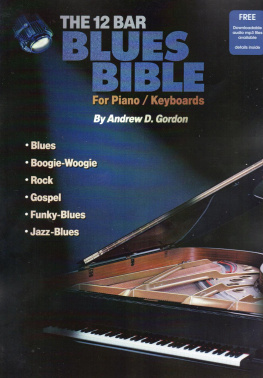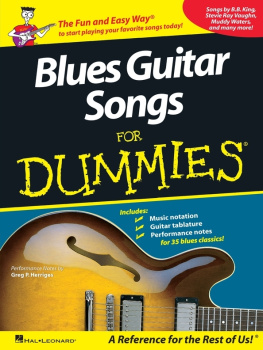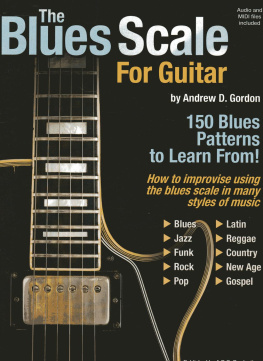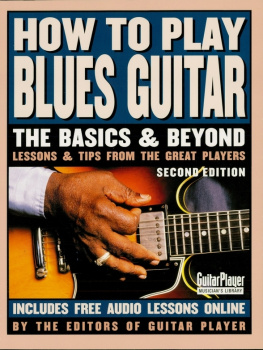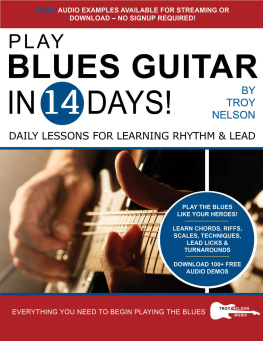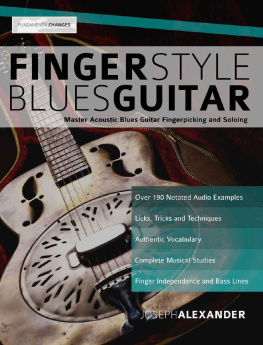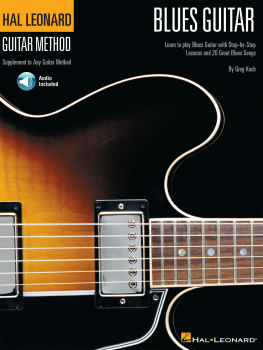Jas Obrecht - Early Blues: The First Stars of Blues Guitar
Here you can read online Jas Obrecht - Early Blues: The First Stars of Blues Guitar full text of the book (entire story) in english for free. Download pdf and epub, get meaning, cover and reviews about this ebook. year: 2015, publisher: University of Minnesota Press, genre: Detective and thriller. Description of the work, (preface) as well as reviews are available. Best literature library LitArk.com created for fans of good reading and offers a wide selection of genres:
Romance novel
Science fiction
Adventure
Detective
Science
History
Home and family
Prose
Art
Politics
Computer
Non-fiction
Religion
Business
Children
Humor
Choose a favorite category and find really read worthwhile books. Enjoy immersion in the world of imagination, feel the emotions of the characters or learn something new for yourself, make an fascinating discovery.

- Book:Early Blues: The First Stars of Blues Guitar
- Author:
- Publisher:University of Minnesota Press
- Genre:
- Year:2015
- Rating:4 / 5
- Favourites:Add to favourites
- Your mark:
- 80
- 1
- 2
- 3
- 4
- 5
Early Blues: The First Stars of Blues Guitar: summary, description and annotation
We offer to read an annotation, description, summary or preface (depends on what the author of the book "Early Blues: The First Stars of Blues Guitar" wrote himself). If you haven't found the necessary information about the book — write in the comments, we will try to find it.
Jas Obrecht: author's other books
Who wrote Early Blues: The First Stars of Blues Guitar? Find out the surname, the name of the author of the book and a list of all author's works by series.
Early Blues: The First Stars of Blues Guitar — read online for free the complete book (whole text) full work
Below is the text of the book, divided by pages. System saving the place of the last page read, allows you to conveniently read the book "Early Blues: The First Stars of Blues Guitar" online for free, without having to search again every time where you left off. Put a bookmark, and you can go to the page where you finished reading at any time.
Font size:
Interval:
Bookmark:
Jas Obrecht

University of Minnesota Press
Minneapolis London
Copyright 2015 by Jas Obrecht
All rights reserved. No part of this publication may be reproduced, stored in a retrieval system, or transmitted, in any form or by any means, electronic, mechanical, photocopying, recording, or otherwise, without the prior written permission of the publisher.
Published by the University of Minnesota Press
111 Third Avenue South, Suite 290
Minneapolis, MN 554012520
http://www.upress.umn.edu
Library of Congress Cataloging-in-Publication Data
Obrecht, Jas.
Early blues : the first stars of blues guitar / Jas Obrecht.
Includes bibliographical references and index.
ISBN 978-1-4529-4565-1
1. Blues (Music)19211930History and criticism. 2. Blues musiciansUnited States. 3. GuitaristsUnited States. 4. Weaver, Sylvester. 5. Jackson, Papa Charlie. 6. Jefferson, Blind Lemon, 18971929. 7. McTell, Blind Willie. 8. Johnson, Blind Willie. 9. Johnson, Lonnie. 10. Hurt, Mississippi John, 18921966. 11. Tampa Red, 19041981. I. Title.
ML3521.O27 2015
787.871643092273dc23 2015023632
The University of Minnesota is an equal-opportunity educator and employer.
For Ava, with love
F IRST AND FOREMOST , I would like to express my appreciation for the original artists profiled in these pages, as well as for the 78 collectors and record companies who have made their recordings available. How lucky we are to live in an era when the complete recorded works of nearly all of the prewar blues musicians are easily accessible. Special thanks to Johnny Parth of Document Records for sending me his CD catalog of prewar blues recordings and to Roger Misiewicz and Helge Thygesen for providing the books 78 label artwork.
I owe a great debt of gratitude to the first wave of blues researchers and writers for their groundbreaking work, as well as for their contributions to this book. Primary among these are Samuel Charters and Paul Oliver, whose writings have inspired generations of blues writers. Mr. Charters graciously permitted me to quote his pioneering research into the lives of Papa Charlie Jackson, Blind Lemon Jefferson, Blind Willie Johnson, and Lonnie Johnson. Paul Oliver gave me audio copies of his original interviews with Lonnie Johnson, which I carefully retranscribed for this book. Chris Albertson, who managed Lonnie Johnsons career in the 1960s, added significant new insights. David Evans, the leading authority on Blind Willie McTell, offered access to his extensive interview materials related to McTell and fact-checked that chapter. Stefan Grossman, who has done much to keep 1920s guitar blues in the public eye, added shrewd observations to many parts of the book. Paramount Records expert Gayle Dean Wardlow shared his research and insight. Alan Balfour extended support and served as a liaison to the community of British blues scholars. Dick Waterman shared his memories and photographs of Mississippi John Hurt and other country bluesmen. Jim ONeal, whose work as the founding editor of Living Blues magazine inspired me to become a music journalist, provided valuable assistance on many fronts.
The insights of many other writers, researchers, and collectors informed these pages: Mary Katherine Aldin, Dean Alger, Moses Asch, Scott Baretta, Bruce Bastin, Derrick Stewart Baxter, Jonathan Black, Matt Blackett, Pen Bogert, Brett Bonner, Toby Byron, Steve Calt, Larry Cohn, Michael Corcoran, Alan Di Perna, Bob Eagle, Anne Evans, Jim Ferguson, Bill Ferris, Richard Flohill, Dan Forte, David Fulmer, Paul Garon, John Goddard, Alan Govenar, Tim Gracyk, Michael Gray, Peter Guralnick, Steve Hoffman, Tom Hoskins, Paul Hostetter, Mark Humphrey, Edward Komara, Peter Lee, David Leishman, Alan Lomax, Thom Carlyle Loubet, Woody Mann, Mike Newton, Robert Palmer, Nick Perls, David Ritz, Mike Rowe, Tony Russell, James Sallis, John Sebastian, Robert Shelton, Victoria Spivey, Dick Spottswood, John Tefteller, Cheryl Thurber, Jeff Todd Titon, Steven C. Tracy, George Van Eps, Guido van Rijn, Dave Van Ronk, Amy van Singel, Hans Vergeer, Max Vreede, Dick Waterman, Pete Whelan, Valerie Wilmer, Bob Yelin, and the staffs of 78 Quarterly, Blues & Rhythm, Blues Access, Blues Unlimited, Guitar Player, Living Blues, Record Research, Sing Out!, and Victrola & 78 Journal. I thank you alland sincere apologies to anyone I missed.
Hats off to the performing artists who agreed to be interviewed for this book: Norman Blake, Rory Block, Ry Cooder, Blind John Davis, Stefan Grossman, John Hammond, John Lee Hooker, Steve James, Jorma Kaukonen, B.B. King, Dan Lambert, Nick Lucas, Country Joe McDonald, Johnny Shines, Pops Staples, and Johnny Winter. Special thanks to Billy Gibbons for making that pilgrimage to Indianapolis all those years ago to interview B.B. King with me.
Acting on Jim ONeals suggestion, I asked expert researcher and cutting-edge discographer Alex van der Tuuk to skim a few of the sections related to Paramount Records. Alex voluntarily went far deeper into the manuscript, updating session dates, personnel, song titles, locations, and, in many cases, biographical information. Thanks to Robert M. W. Dixon, John Godrich, and Howard Rye for their monumental reference book Blues & Gospel Records, 18901943; to Mike Leadbitter, Leslie Fancourt, Paul Pelletier, and Neil Slaven for Blues Records, 19431970; and to Guido van Rijn and Alex van der Tuuk for their New York Recording Laboratories Matrix Series, volumes 14. These books, completed as labors of love, are must-haves for researchers of prewar blues music.
I am indebted to Erik Anderson of the University of Minnesota Press for recruiting and encouraging me to write this book.
Finally, a very special thanks to my friends and family for their support and encouragement during the three decades that this book has been in progress: Jim Crockett, Ira Fried, Joe Gore, Steve Hilla, Don Menn, Tom Mulhern, Arthur Obrecht, John Obrecht, Tom and Kathy Obrecht, James Rotondi, Jon Sievert, George and Marie Staley, Rosedell Thomas, Sheridan and Betsey Warrick, and Tom Wheeler. Most of all, blessings on my wife and daughter, Michelle and Ava, for being my heart, soul, and inspiration.
T HE FIRST GREAT FLOWERING OF BLUES RECORDING began in the early 1920s with the rise of classic women singers such as Mamie Smith, Alberta Hunter, Ida Cox, Bessie Smith, and Ma Rainey. By the end of the decade, a dazzling array of male stars had made it onto record as well. This wonderfully fertile era, which laid the groundwork for virtually all the guitar-based blues music played today, came to an end with the onset of the Great Depression.

Record companies during the 1920s marketed 78s by African Americans as race records, sometimes featuring racist stereotypes in their advertisements. Courtesy Tim Gracyk.
This book profiles the most prominent singer-guitarists who made influential and enduring recordings during the Roaring Twenties. Many other now-famous musicians were also performing guitar blues during this eraBig Bill Broonzy, Blind Boy Fuller, Blind Gary Davis, Memphis Minnie, Son House, and Lead Belly, to name a fewbut the majority of their recordings came during the 1930s and afterward.
The first strains of blues music echoed across the American South, most likely around the beginning of the twentieth century. The exact origins of the blues are obscured in a swirling milieu of field hollers and work songs, African music, spirituals, ragtime, minstrel fare, folk tunes, parlor music, and other musical styles, but one fact is certain: since the mid-1920s, the blues and the guitar have traveled side by side.
Font size:
Interval:
Bookmark:
Similar books «Early Blues: The First Stars of Blues Guitar»
Look at similar books to Early Blues: The First Stars of Blues Guitar. We have selected literature similar in name and meaning in the hope of providing readers with more options to find new, interesting, not yet read works.
Discussion, reviews of the book Early Blues: The First Stars of Blues Guitar and just readers' own opinions. Leave your comments, write what you think about the work, its meaning or the main characters. Specify what exactly you liked and what you didn't like, and why you think so.

